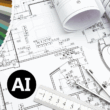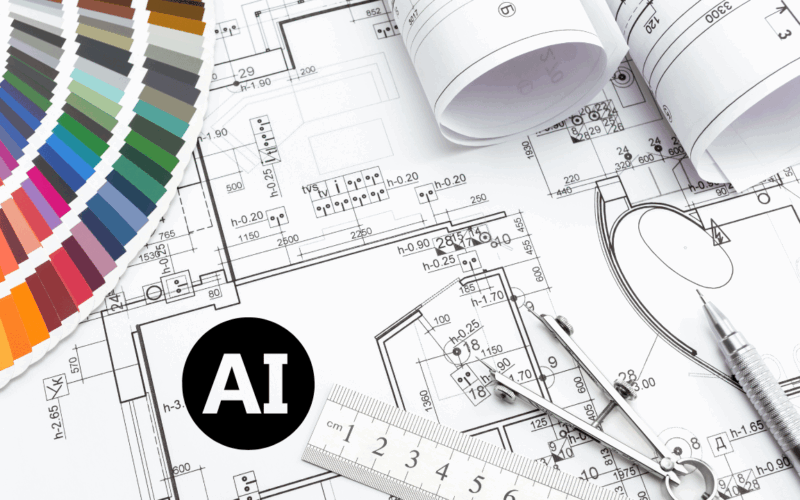Architecture and interior design have always balanced creativity with precision. But in recent years, a new player has entered the scene. So, artificial intelligence. What was once a buzzword is now a daily tool in studios and firms worldwide, transforming how professionals conceptualize, plan, and execute their work. In this article, we’ll explore how AI is changing architecture and interior design with top tools and artificial intelligence trends.
From generating mood boards in seconds to predicting building performance before construction begins, AI is no longer just an add-on. So, it’s becoming central to the creative process. For architects, interior designers, and even homeowners, the shift is opening new possibilities while raising fresh questions about the future of design.
Why AI Matters in the Design World
AI is not replacing architects or interior designers, but it is redefining their roles. Instead of spending hours on repetitive drafting, material sourcing, or rendering, professionals can focus more on ideation and client collaboration. This shift allows designers to explore more concepts, iterate faster, and personalize projects to a degree that would have been impractical just a decade ago.
It also democratizes access to design tools. Homeowners, small business owners, and design students can now use AI-powered platforms to visualize ideas without needing advanced technical skills. The result is a more collaborative, data-informed, and efficient design process.
AI in Concept Development: Architecture & Interior Design
One of the earliest stages of any design project is concept generation, and this is where AI shines. Generative design platforms can create dozens or even hundreds of design variations based on parameters like size, function, style, and budget.
Tools like Midjourney, DALL·E, and Stable Diffusion allow designers to quickly create visual references for a project. An architect might feed in details such as “minimalist two-story home with natural light and open floor plan” and receive multiple photorealistic options to review. This rapid idea generation doesn’t replace creativity but accelerates the brainstorming phase dramatically.
For interior designers, AI can build instant mood boards by pulling textures, colors, and furniture styles from vast databases. Instead of searching through catalogs manually, they can have curated style suggestions ready for client review in minutes.
AI for Visualization and Rendering
Traditional 3D rendering is resource-heavy and time-consuming, often requiring hours of work and powerful computing resources. AI-based rendering engines can now produce high-quality visuals in a fraction of the time.
These tools use machine learning to understand lighting, materials, and spatial relationships, allowing them to generate realistic images that rival traditional rendering methods. AI can even create immersive virtual walkthroughs so clients can “step into” their future spaces before construction begins.
This technology not only speeds up approvals but also reduces misunderstandings between designers and clients. When both parties can see the same detailed vision, projects stay on track.
Data-Driven Space Planning: Architecture & Interior Design AI
AI doesn’t just help with aesthetics. In addition, it improves functionality. By analyzing data from existing buildings, AI can suggest optimal layouts for traffic flow, natural light usage, and energy efficiency.
For example, an AI tool can study patterns of movement in an office space and recommend furniture placement that encourages collaboration while minimizing noise. In residential design, AI might suggest window placements to maximize daylight while maintaining privacy.
These insights are based on real-world performance data, making them more reliable than purely instinctive design decisions.
Material Selection and Sustainability
Sourcing sustainable materials is a growing priority in architecture and interior design. AI platforms can analyze material properties, environmental impact, and cost to recommend the best options for a project.
This helps designers make informed decisions that balance beauty, durability, and sustainability. AI can also track emerging materials and suppliers, ensuring designers stay ahead of trends and compliance requirements.
Some tools go even further, predicting the long-term performance of materials in specific climates, which helps reduce maintenance costs and extend the life of a building.
Collaboration and Client Engagement
One of AI’s most underrated benefits in design is its ability to improve communication between designers and clients. Interactive AI platforms allow clients to make real-time changes to a design. So, such as swapping colors, furniture, or layouts and instantly see the results.
This collaborative approach keeps clients engaged and reduces the risk of costly revisions later in the project. It also empowers clients to feel more invested in the final outcome, as they’ve played a hands-on role in shaping it AI changing architecture.
Table: Key AI Tools for Architecture & Interior Design
| Tool/Platform | Primary Function | Ideal For |
|---|---|---|
| Midjourney | AI-generated concept visuals | Mood boards, style exploration |
| Stable Diffusion | Custom photorealistic renders | Early-stage visual development |
| Autodesk Forma | AI-driven space planning and building analysis | Optimizing layouts, energy efficiency |
| Morpholio Board | AI-assisted mood board and product sourcing | Interior design presentations |
| TestFit | Generative design for site and building planning | Architects working on feasibility studies |
| Spacemaker AI | Site analysis and optimization | Urban planning and sustainable design |
| Foyr Neo | AI-powered interior visualization and walkthroughs | Client presentations and real estate marketing |
AI Trends Shaping the Future of Design: Architecture & Interior
Several emerging trends show how deeply AI will integrate into architecture and interior design in the coming years AI changing architecture.
Generative Design at Scale
AI will enable architects to explore thousands of variations for complex projects, finding solutions that balance aesthetics, cost, and environmental factors.
Personalized Interiors AI Architecture Tools Trends
By combining AI with user data—like preferences, lifestyle habits, and even biometric feedback designers will be able to create spaces tailored to an individual’s exact needs and tastes.
Predictive Maintenance and Smart Spaces
AI can help buildings “self-monitor” by predicting when elements like HVAC systems or lighting need attention, reducing downtime and costs.
Immersive Mixed Reality
AI combined with augmented and virtual reality will make design presentations even more interactive, letting clients walk through spaces at 1:1 scale before any construction begins.
Sustainability-First Design AI Architecture Tools Trends
With stricter environmental regulations, AI will be central to optimizing resource use, reducing waste, and sourcing eco-friendly materials.
Challenges and Considerations
While AI brings incredible opportunities, it’s not without challenges. Designers must ensure that technology supports, rather than overrides, human creativity. There’s also a learning curve in adopting new platforms, and some tools come with subscription costs that can be significant for small firms.
Ethics and originality are another concern. AI-generated visuals often draw from existing works, which can raise questions about intellectual property. Professionals need to be transparent with clients about which aspects of a design were AI-assisted.
Finally, while AI can suggest optimal solutions based on data, it lacks the human sensitivity to culture, history, and emotional resonance. The best results come when AI augments rather than replaces the designer’s vision, AI changing architecture.
Final Thoughts AI Architecture Tools Trends
Artificial intelligence is reshaping architecture and interior design in ways that would have been hard to imagine even five years ago. It’s speeding up workflows, expanding creative possibilities, and making data-driven decisions a standard part of the process.
For architects and designers willing to adapt, AI offers the chance to spend more time on the art of design and less on repetitive tasks. For clients, it promises faster results, better communication, and highly personalized spaces.
The future of design won’t be about choosing between human or machine. So, it will be about the synergy between the two. The most successful projects will come from designers who use AI as a creative partner, not just a technical shortcut.








